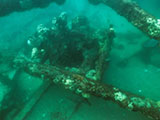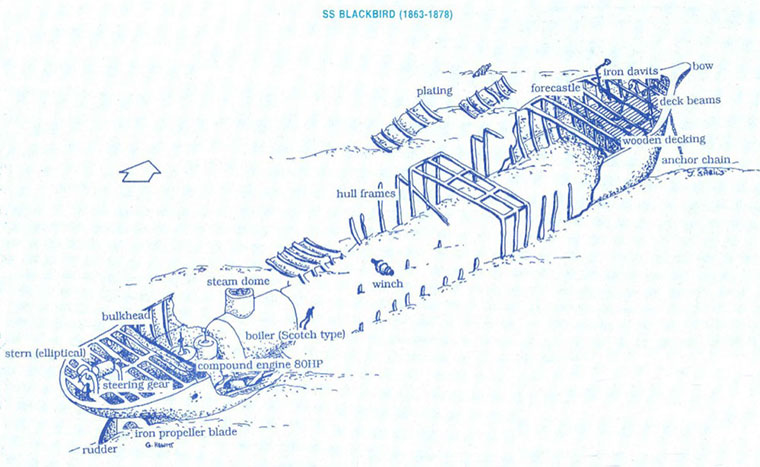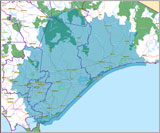Blackbird
![]() Wreck Dive |
Wreck Dive | ![]() Boat access
Boat access
![]()
![]()
![]()
Iron Screw Steamer | Max Depth: 19 m (62 ft)
Level: Open Water and beyond.
The Blackbird (aka SS Blackbird) was a mid-19th century steamship initially designed to carry cargo and passengers but later converted to carry coal. It was built in Newcastle on Tyne.
The Blackbird lies off the southern shore of Clonmel Island, Corner Inlet, at the Port Albert entrance, on Victoria's East Gippsland Coast, in shallow water, quite close to the location of PS Clonmel (1836-1841), Australia's earliest steamer wreck.
The SS Blackbird is archaeologically and recreationally significant as a representative example of an auxiliary steamer involved in the Australian colonial coastal trade.
Diving the Blackbird Shipwreck
The wreck of the Blackbird lies some 300 to 400 metres from the southern shore of Clonmel Island in shallow water. The remains of the boiler steam dome is just awash at low tide and the wreck constitutes a distinct hazard to navigation in the area. The site is approximately 1.5 nm (2.78 km) north-east of Port Albert entrance.
The Blackbird wreck site is often subject to poor visibility, strong surge and a current running parallel to the shore. Access to the site is severely restricted by weather and sea conditions, Port Albert having one of the most difficult and dangerous estuarine entrances on Victoria's south-east coast. The sand bars and banks at the entrance, constantly shift and local knowledge is essential for safe navigation. From seaward, the coast is low and features are few. The site is exposed to weather from south to east.
A dive on the Blackbird shipwreck is a fine opportunity to see a mid-19th-century steamship of traditional shape in a remarkably intact state. The wreck of Blackbird lies nearly upright on the keel, parallel to the shoreline with the bow to the north-east. The hull is intact to deck level at the bow and stern but is breached for most of its length. The hull is sunk into the sand to the approximate position of the light load water-line. The remains of the boiler steam dome is just awash at low tide. The clipper bow and the counter stern of the Blackbird are still remarkably intact.
There is plenty of marine life on the wreck, including Seahorses and Eels. Other creatures of interest include Singrays, Port Jackson sharks and the usual species of fish.
See WillyWeather (Clonmel Island) as a guide for the tide times and the height of the tide.
Bass Strait Warning: Always keep an eye on sea conditions throughout any shore or boat dive in Bass Strait on Victoria's coastline. Please read the warnings on the web page diving-in-bass-strait before diving or snorkelling this site.
Blackbird Shipwreck History — Built in 1863
The Blackbird was built in 1863 by C. Mitchell & Co in Low Walker, Newcastle, England as an iron screw barque with a three-masted barque auxiliary rig, for Grice Sumner and Co. of Melbourne. She had an overall length of 196.4 ft (60 m), beam 28.4 ft (8.66 m) and draught 16.7 ft (5.09 m).
Blackbird was fitted with a two-cylinder, direct-acting engine of 36 inch bore and 30 inch stroke, giving 80 horsepower. Her engine was built by R. Morrison and Co., of Newcastle. Steam was raised in a 12 foot diameter horizontal Scotch-type fire-tube boiler and, according to Lloyds Register, her hull was subdivided by four bulkheads. The machinery was set well aft with the boiler uptake probably between the main and mizzen masts.
As a new ship, Blackbird made several journeys to New Zealand. Later, it carried cargo to east coast ports of Australia including Rockhampton. For a short period it was also used to ferry passengers and cargo between Adelaide and Melbourne. Blackbird replaced SS Penola on this run, also owned by Grice Sumner and Co., during repairs to the latter vessel as a result of damage sustained in the collision which sank the SS City of Launceston in Port Philip on 19 November 1865.
The growth of Melbourne and development of its industry created a need for coal to power machinery. Victoria's existing coal fields at Kilcunda and Cape Patterson could not cope with the increasing demand for coal and authorities turned to Newcastle as an alternative source.
Newcastle had abundant coal reserves and good facilities for ships. From 1874 until 1878, when the vessel was wrecked, SS Blackbird regularly made the journey to Newcastle to be loaded with coal bound for Melbourne, although it's known she also carried passengers.
Originally classified 9A1 at Lloyds, having been built under special survey, SS Blackbird was surveyed at Sydney during October 1873 and registered there during 1874. SS Blackbird was purchased from Grice Sumner and Co. by Sydney interests during 1876, the new owners being Captain A. Campbell and others.
Blackbird Sinking — Wrecked 2 June 1878
The steam collier Blackbird went ashore on the southern side of Clonmel Island, Port Albert, South Gippsland, eastern Victoria, in the same gale that wrecked the Loch Ard in western Victoria. However, in this wreck, all reached safety.
The Blackbird ran ashore just after 3 a.m. on Sunday 2 June 1878 while on a voyage from Newcastle to Melbourne with a cargo of 800 tons of coal consigned to Lyell and Gowan of Melbourne. It was under the command of Captain John McConachy, with a crew of 24 and three paying passengers.
Blackbird left Newcastle NSW at 5 a.m. on Thursday 30 May 1878. Light westerly winds prevailed until Ram Head was passed about 9.30 p.m. on the Friday when the wind changed to SW by S and continued with heavy squalls of rain until noon on Saturday.
The distance between Newcastle and Ram Head is about 400 nm (741 km), and Blackbird covered this distance at a creditable average of 10 knots (19 kpm). Sailing conditions would have been good, with an offshore wind and the ship on a starboard reach with the wind a little forward of the beam. With the wind change, the weather would have been largely "on the beak". The unpleasant conditions continued until noon on the Saturday when the wind veered to SSE and Blackbird was probably then close hauled on the port tack. The wind stayed in that quarter until the steamer struck. Ram Head is approximately 200 miles from Port Albert and that distance was covered in some 30 hours which indicates an average speed of less than 7 knots, which is consistent with head winds.
About 3 a.m. on the Sunday morning, Latrobe Island Light was sighted but Captain McConachy mistook it for the light on Wilsons Promontory. Latrobe Island Light was inside Port Albert Entrance, on the north-east tip of Latrobe or Snake Island. William Mungall, the Mate, noticed the appearance of white water on the port bow, but in consultation with the look-out, dismissed this as a shoal of fish.
Blackbird went aground immediately afterwards, probably near the seaward end of the east bar at the entrance, the end of which breaks continuously some two miles from a low and undistinguished shore.
The engines were reversed at full speed and the fore topsail yards put aback, freeing the ship from the sand. The Captain then came on deck and ordered the helm to be put hard down in an attempt to back the steamer off into deep water. Blackbird continued to go astern for ten minutes but then orders were given to go full ahead and make sail, steering north to clear a supposed reef.
McConachy here made a fatal error, for in less than a quarter of an hour, when the call came that breakers were seen on both bows, Blackbird was heading directly for the beach on Clonmel Island. Despite the engines being again put full astern and the helm hard a-port, the steamer struck on the beach. Blackbird swung broadside on to the breakers and stuck fast where she now lies, with her bow facing to the east.
Reckless navigation was deemed to have caused the wreck of the Blackbird on Clonmel Island. The Board found the charge against Captain John McConachy proven and suspended his certificate for 12 months. William Mungall, the Mate, had his certificate suspended for 3 months.
See also, MMAV: S.S. Blackbird 1863-1878,
Heritage Council Victoria: Blackbird,
Heritage Victoria slide collection on flickr: SS Blackbird,
Australian National Shipwreck Database: Blackbird, and
Dive Information Sheet: SS Blackbird (1863-1878).
Heritage Warning: Any shipwreck or shipwreck relic that is 75 years or older is protected by legislation. Other items of maritime heritage 75 years or older are also protected by legislation. Activities such as digging for bottles, coins or other artefacts that involve the disturbance of archaeological sites may be in breach of the legislation, and penalties may apply. The legislation requires the mandatory reporting to Heritage Victoria as soon as practicable of any archaeological site that is identified. See Maritime heritage. Anyone with information about looting or stolen artefacts should call Heritage Victoria on (03) 7022 6390, or send an email to [email protected].
This vessel is one of the many historic shipwrecks included in Victoria's shipwreck-discovery-trail. Qualified divers can explore the wrecks of old wooden clippers, iron steamships and cargo and passenger vessels located along the coast and in Port Phillip. Some of these wreck dives are suitable for beginners, even snorkellers, while other wrecks require the skills and experience of advanced divers.
Finding the Blackbird Shipwreck
Over the years we've been provided with different GPS marks for the Blackbird shipwreck. The GPS marks we know of in circulation for the Blackbird are:
- GPS:
Latitude: 38° 43.268′ S (38.721133° S / 38° 43′ 16.08″ S)
Longitude: 146° 41.902′ E (146.698367° E / 146° 41′ 54.12″ E)
- Maritime Archaeology Association of Victoria:
Latitude: 38° 43.750′ S (38.72916667° S / 38° 43′ 45″ S)
Longitude: 146° 41.750′ E (146.69583333° E / 146° 41′ 45″ E)
920 m, bearing 193°, SSW
Compass Bearings:
1. Mount Roundback — 323° (T)
2. Kay Hill — 270° (T)
Traditional Owners — This dive site is in the traditional Country of the Gunaikurnai people of south-eastern Victoria including a large part of Gippsland. This truly ancient Country includes the coastal and inland areas to the southern slopes of the Victorian Alps, plus Buchan Caves, Port Albert, Moe, Morwell, Traralgon, Yarrum, Sale, Mafra, Bairnsdale, and Lakes Entrance. It also stretches 100 metres out to sea from low tide. "Gunaikurnai" is a name adopted by the people of the Brataualung, Brayakaulung, Brabralung, Krauatungalung and Tatungalung family clans. We wish to acknowledge the Gunaikurnai as Traditional Owners. We pay respect to their Ancestors and their Elders, past, present and emerging.
Blackbird Location Map
Latitude: 38° 43.268′ S (38.721133° S / 38° 43′ 16.08″ S)
Longitude: 146° 41.902′ E (146.698367° E / 146° 41′ 54.12″ E)
Datum: WGS84 |
Google Map
Added: 2012-07-22 09:00:00 GMT, Last updated: 2022-05-10 02:59:36 GMT
Source: GPS
Nearest Neighbour: Clonmel, 3,106 m, bearing 215°, SW
Iron Screw Steamer.
Built: Newcastle on Tyne, 1863.
Sunk: 2 June 1878.
Clonmel Island, Port Albert.
Depth: 19 m.
[ Top ]
DISCLAIMER: No claim is made by The Scuba Doctor as to the accuracy of the dive site coordinates listed here. Should anyone decide to use these GPS marks to locate and dive on a site, they do so entirely at their own risk. Always verify against other sources.
The marks come from numerous sources including commercial operators, independent dive clubs, reference works, and active divers. Some are known to be accurate, while others may not be. Some GPS marks may even have come from maps using the AGD66 datum, and thus may need be converted to the WGS84 datum. To distinguish between the possible accuracy of the dive site marks, we've tried to give each mark a source of GPS, Google Earth, or unknown.





